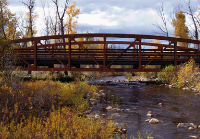Crossings Permitting
Waterway protection
Notes on Waterways Crossings Permits
For each crossings project type below, if an exemption or a general permit is available, you will find a link to a checklist of requirements. If your project does not meet exemption eligibility criteria, review the general permit checklist. If your project does not meet general permit eligibility criteria, you must apply for an individual permit.
To start a permit application, use the DNR Water ePermitting System. A WAMS ID is required.
To determine if a local permit or a federal permit is required for your project, contact your city or county zoning authority and the U.S. Army Corps of Engineers – St. Paul District Office.
For some waterway projects, a water quality certification (WQC) may be required from DNR as the certifying authority under the Clean Water Act Section 401. WQC requests will be considered complete through a waterway permit application and the DNR Waterways Program typically reviews WQC requests in parallel with permit review. See WQC Request Completeness Elements for the full list of requirements.
State law requires a landowner with a project site that is 1 acre or larger in size to obtain a construction site stormwater permit. To submit a notice of intent, visit the DNR Stormwater Runoff Permitting page.
Applicable state statutes and code include s. 30.123, Wis. Stats., and NR 320 Wis. Adm. Code.
Crossings Project Types
Bridges
A bridge is defined in statute as "any structure constructed in or over a navigable waterway to provide a walkway or roadway for pedestrians, animals, or vehicles, and includes pipe arches and culverts."
For bridges constructed as part of a Municipal or WisDOT highway project, contact DNR transportation liaison staff who manage the review of transportation projects.
If you need to rebuild a bridge after a flood or natural disaster in an emergency situation, contact a waterways team member.
A permit is required to place a new bridge over a navigable waterway. A bridge that spans a waterway without pilings and is not located on designated wild river may be eligible for a general permit. If your project does not meet general permit eligibility, you must apply for an individual permit.
Permitting Options
Bridge Technical Resources
Fords
A ford is a structure, typically built with rocks or timber, that is placed flush with the stream bed to aid vehicles in driving through the water while crossing the stream. The placement of highly moveable materials such as sand is prohibited in streams.
A permit is required to install a ford. For fords placed in streams that are less than 100 ft. wide, have a normal depth of 6 inches or less, and have less than 2 ft. of bottom sediment, a general permit may be available if all other criteria are met. If your project does not meet general permit eligibility, you must apply for an individual permit.
Permitting Options
- Waterways Crossing General Permit Checklist (3500-130)
- Ford Crossing of Streams Individual Permit Checklist
Ford Technical Resources
Culverts
To minimize the impact a water crossing has on the environment, culverts require the proper size, design and installation to ensure that they don't cause erosion downstream, flood upstream properties, alter stream habitat or block aquatic organism passage.
For culverts constructed as part of a public road or highway project, contact DNR transportation liaison staff who manage the review of transportation projects.
A culvert replacement project may be exempt if the new culvert is placed in substantially the same location and meets all criteria in the exemption checklist.
A permit is required to install a new culvert. If your new culvert project does not meet general permit eligibility, you must apply for an individual permit.
Permitting Options
- Culvert Replacement Exemption Checklist
- Waterways Crossing General Permit Checklist (3500-130)
- Culvert Individual Permit Checklist
Culvert Technical Resources
Temporary In-Stream Crossing for Forest Management
A temporary crossing, such as a bridge or ford, placed in a navigable stream that is less than 10 feet wide for access related to forestry activities is required to have a permit. If the temporary crossing if 10 feet wide or greater, you must apply for a bridge or ford permit. If your project does not meet general permit eligibility, you must apply for an individual permit.
Permitting Options
Utility Crossing
Permitting for utility projects is handled by the DNR Environmental Analysis and Sustainability (EAS) Program. Use their Utility Permitting page to determine permit needs.
Please contact DNR EAS staff prior to submitting a permit application.

